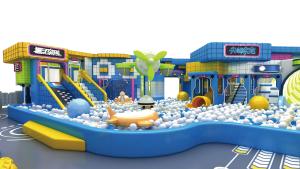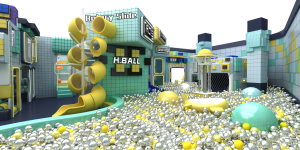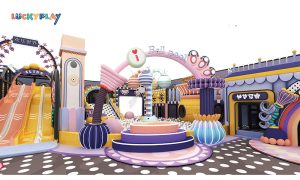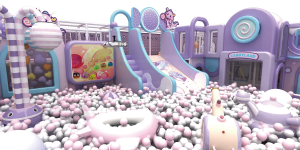Designing safe and fun indoor playgrounds requires careful consideration of various factors to create engaging and secure environments for children. Choosing the best equipment is fundamental to achieving these goals, as it directly impacts the play experience and safety of young users. From soft play structures to interactive games and themed play areas, each piece of equipment should be selected based on safety standards, durability, and age-appropriate features.
This comprehensive guide explores essential considerations for designing indoor playgrounds that prioritize both safety and enjoyment. By selecting the right equipment and adhering to best practices, indoor spaces can foster creativity, physical activity, and memorable play experiences for children of all ages.

What is Indoor Playground Equipment?
Indoor playground equipment encompasses a variety of structures and features designed for children’s recreational activities within enclosed spaces. These include climbing frames, slides, ball pits, tunnels, and interactive play panels.
Why Choose Indoor Playgrounds Over Outdoor Options?
Indoor playgrounds offer several advantages over outdoor options, including year-round accessibility regardless of weather conditions. They provide a controlled environment with consistent safety measures and supervision, making them ideal for children’s play regardless of external factors.
What are the Key Benefits of Indoor Playground Equipment?
Indoor playground equipment provides numerous benefits, such as promoting physical activity in a safe and supervised environment. It enhances children’s motor skills, social interaction, and creativity through interactive play structures designed for various age groups. Additionally, indoor playgrounds offer versatile options that can be tailored to fit different space constraints and design preferences, ensuring optimal use of indoor areas for recreational purposes.
What Types of Indoor Playground Equipment are Available?
Indoor playground equipment for sale encompasses a wide range of structures tailored to enhance children’s play experiences. These include:
1. Climbing Structures: Featuring ropes, nets, and platforms that encourage physical activity and coordination.
2. Slides: Various sizes and styles of slides designed for different age groups, promoting excitement and motor skill development.
3. Ball Pits: Enclosed areas filled with soft balls that provide tactile stimulation and sensory play.
4. Interactive Play Panels: Panels with buttons, gears, and puzzles that engage children in interactive and educational play.
5. Obstacle Courses: Courses designed to challenge agility, balance, and problem-solving skills in a safe environment.

6. Soft Play Areas: Cushioned surfaces and foam structures that offer a safe and comfortable space for toddlers and younger children to explore.
7. Themed Play Structures: Custom-designed structures based on themes such as jungles, castles, or outer space, enhancing imaginative play experiences.
Each type of equipment serves to promote physical activity, social interaction, and cognitive development in children, making indoor playgrounds vibrant and engaging spaces for play and learning.
How to Choose the Right Indoor Playground Equipment for Different Age Groups?
Selecting appropriate indoor playground equipment for different age groups involves several considerations to ensure safety and engagement:
1. Age Appropriateness: Match equipment features to the developmental stages of children. For toddlers, focus on low-height structures with soft surfaces and minimal climbing challenges. Older children can handle more complex structures with higher platforms and challenging activities.
2. Safety Features: Prioritize equipment with rounded edges, non-slip surfaces, and secure railings to prevent accidents. Ensure equipment meets safety standards and is regularly inspected and maintained.
3. Play Value: Choose equipment that promotes physical activity, social interaction, and cognitive development. Include a variety of activities like climbing, sliding, and imaginative play to cater to different interests.
4. Space and Layout: Consider the available space and layout of the indoor playground. Arrange equipment to maximize use of space while allowing for adequate supervision and circulation.
5. Durability and Maintenance: Opt for durable materials that withstand frequent use and are easy to clean. Regularly maintain equipment to ensure longevity and safety.
By carefully considering these factors, indoor playgrounds can offer age-appropriate and stimulating environments that support children’s growth, development, and enjoyment.
What Safety Features Should You Look for in Indoor Playground Equipment?
Ensuring indoor playground equipment is equipped with essential safety features is paramount to creating a secure and enjoyable environment for children. Soft surfaces, such as foam padding or rubber mats beneath climbing structures and slides, help cushion falls and reduce the risk of injuries. Rounded edges and smooth surfaces throughout the equipment prevent cuts or bruises during play. Non-slip materials on steps and platforms provide traction, enhancing stability even in humid or wet conditions.

Sturdy railings and enclosures around elevated areas ensure children’s safety by preventing accidental falls. Equipment should also be designed to prevent entrapment, with small gaps or openings that do not pose a hazard. Accessibility features, like ramps and inclusive design elements, ensure that children of all abilities can participate safely. Regular maintenance and adherence to installation guidelines are crucial to maintaining the integrity of safety features over time.
By prioritizing these aspects, indoor playgrounds can offer a safe and inviting space where children can explore, interact, and develop their physical and social skills with confidence.
How to Design an Engaging and Fun Indoor Playground Layout?
Designing an engaging and fun indoor playground layout involves thoughtful planning to create a dynamic and stimulating environment for children. Start by considering the available space and age groups the playground will serve. Divide the area into zones that cater to different types of play, such as active play, sensory play, and quiet areas for reading or rest.
Incorporate a variety of equipment, including climbing structures, slides, ball pits, and interactive play panels, to offer diverse play experiences. Arrange equipment to allow for smooth traffic flow and supervision, ensuring safety and accessibility throughout the space. Incorporate vibrant colors, themed decorations, and murals to create a visually appealing atmosphere that sparks imagination and creativity. Include seating areas for caregivers and ensure clear sightlines to monitor children’s activities.
Finally, solicit feedback from children and caregivers to fine-tune the layout and ensure it meets their expectations for enjoyment and engagement. By balancing safety, variety, and creativity, a well-designed indoor playground layout can provide a stimulating and memorable play experience for children of all ages.
What Materials Are Commonly Used in Indoor Playground Equipment?
Indoor playground equipment is typically constructed from a variety of materials chosen for their durability, safety, and suitability for children’s play environments. Common materials include:
1. Metal: Steel or aluminum frames provide structural strength and stability for climbing structures, slides, and overhead bars.
2. Plastic: High-density polyethylene (HDPE) and other durable plastics are used for slides, play panels, and climbing components due to their lightweight nature and resistance to wear and tear.

3. Foam: Soft foam padding or mats are used beneath play structures to cushion falls and reduce impact injuries.
4. Fabric: Nylon or polyester fabrics are used for tunnels, netting, and covering components to create enclosed play areas and climbing nets.
5. Wood: Treated or coated wood is sometimes used for aesthetic purposes in play structures, benches, or themed elements.
6. Rubber: Rubber flooring tiles or mats provide a non-slip surface under and around play equipment, enhancing safety and comfort.
7. Elastomers: Elastic materials like rubber bands or springs are used in interactive play panels and components that children can pull or stretch.
These materials are selected based on their ability to withstand heavy use, resist weathering or moisture in indoor environments, and meet safety standards for children’s play equipment. Regular maintenance and cleaning help prolong the lifespan of these materials, ensuring safe and enjoyable play experiences for children.
How to Maintain and Clean Indoor Playground Equipment?
Maintaining and cleaning indoor playground equipment is essential to ensure a safe and hygienic play environment for children. Start by establishing a regular maintenance schedule to inspect all equipment for signs of wear, damage, or loose components. Tighten bolts and fasteners as needed and replace any worn-out or broken parts promptly to prevent accidents. Clean surfaces regularly using mild soap and water to remove dirt, germs, and residues.
Use disinfectants approved for use on playground equipment to sanitize high-touch surfaces like handrails, slides, and play panels. Pay special attention to areas prone to spills or contamination, such as ball pits or foam blocks, and clean these thoroughly according to manufacturer guidelines. Allow equipment to dry completely before allowing children to play to prevent slips and ensure safety.

Educate staff and caregivers on proper cleaning protocols and encourage them to report any maintenance issues promptly. By maintaining a proactive approach to cleaning and maintenance, indoor playgrounds can provide a clean and safe environment where children can play and explore with peace of mind.
Conclusion:
In conclusion, when considering the purchase of an indoor playground, ensuring safety, durability, and engaging play experiences should be your priority. At Lucky Play, we are committed to providing high-quality indoor playground solutions that meet these standards.
Whether you’re looking to create a vibrant play space for a daycare, school, or community center, our team is dedicated to helping you design and install the perfect indoor playground that children will love. Contact us today to explore our wide range of playground equipment options and tailored solutions. At Lucky Play, we’re here to bring joy and safety to your indoor play environment.









